Joe Biden's path to the nomination
Data offer us some clues about Biden's prospects, but we really need new polls to know what comes next
Being a data-driven journalist is tough some times. Usually, I get stuck for two reasons. Often, it’s that I don’t have the data I need to answer a question. But sometimes the problem is that I have too much data to look at. Signals get crossed. Narratives conflict. Finding my way out of the data cave proves time-intensive.
There are also times when, paradoxically, I encounter both of these issues. Today is one of those days.
Last night, Joe Biden won a series of surprise victories across 14 Super Tuesday states (and 1 territory). Depending on how you frame it, Biden has either staged one of the most remarkable comebacks in modern political history (no one has prior lost the first three states and survived), or he has simply lucked out that the latter states were his strong ones.
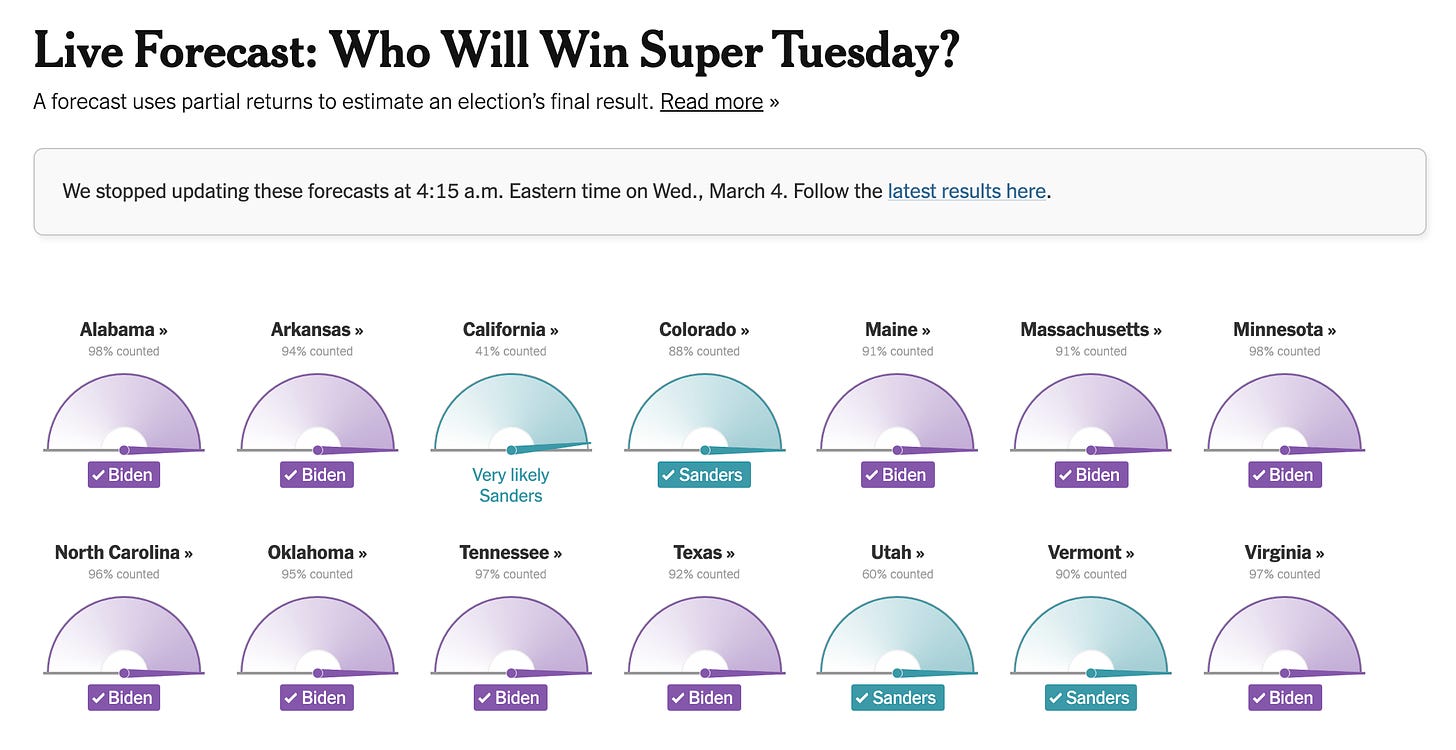
Yet despite the urgency of the moment, we don’t have a lot of new data to gauge the impacts of Biden’s upset last night. Naively, we might reckon that he’s destined for the nomination. Some political pundits are already labeling him the Democrats’ presumptive nominee.
Is this wrong? I’m of the opinion that, at the very least, it’s too certain a take to be taken seriously. But from a data-driven view, we’re really flying blind. What happens now? Where does the primary go from here?
It’s in times such as these that I like to act more like an accountant than a journalist, scouring the internet for data that other people have compiled that may offer some clues about our politics.
So here is what I have found that might provide some clues as to why Biden beat expectations last night, and what we might expect in the coming states.
1. Late-deciders broke for Biden (and against Sanders)
In the run-up to last night’s elections, Joe Biden enjoyed a surge in endorsements and media attention, two factors commonly associated with electoral success. It’s no wonder, then, that people who decided in the last few days of the contest broke hard for him. Data crunched by FiveThirtyEight’s Laura Bronner indicate that Biden doubled his vote share among late-compared to earlier-deciders in Vermont, Massachusetts, Minnesota and Tennessee and increased by 5-10 percentage points each in delegate-rich Texas, North Carolina and Virginia.
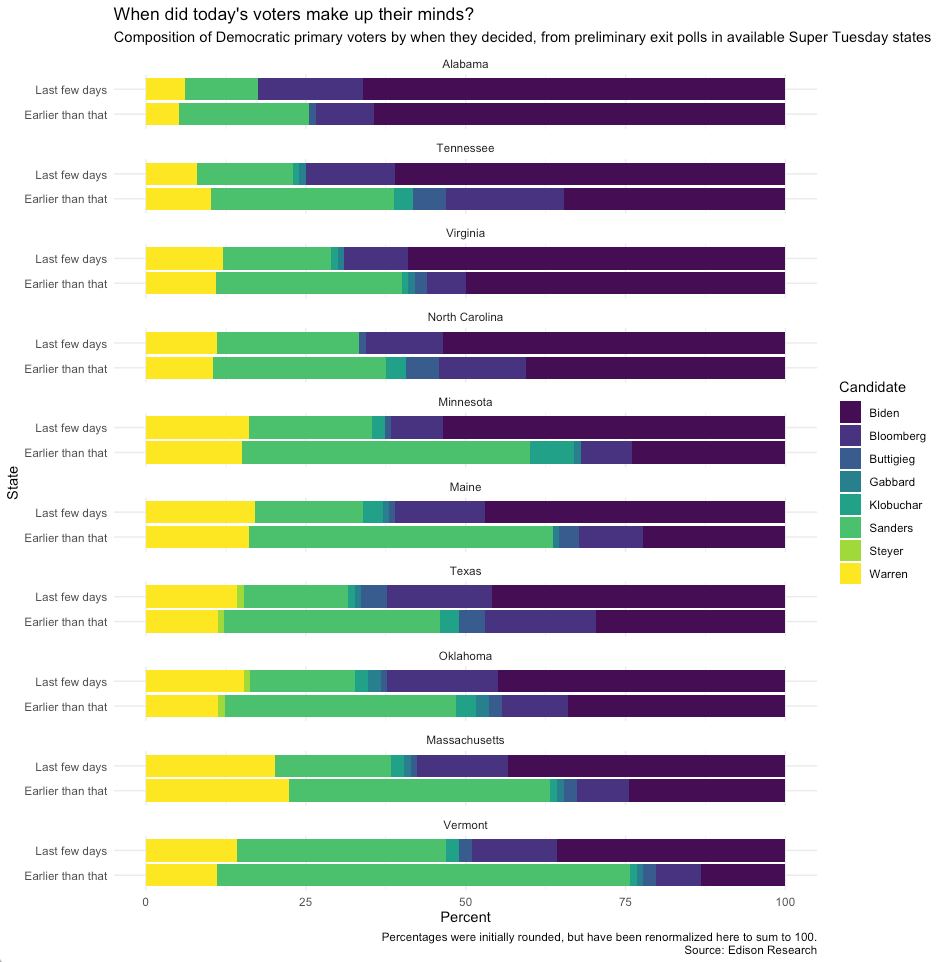
For Sanders, note that his vote share was cut in half among late-deciders in Massachusetts, Texas, Maine and Minnesota.
If Biden continues to perform well with voters who are deciding “late” in the primary—which we should maybe expect, given that Sanders’s supporters are pretty loyal, and his vote share is probably closer to its ceiling now than Biden’s—we should expect him to expand his bigger delegate lead as the contest goes on.
2. Biden is hugging Clinton in the south
A big story of the 2016 primary was the regional differences in Clinton’s and Sanders’s vote shares. This is not wholly surprising; vote intention varies by race, and racial composition varies greatly by regions.
The same story seems to be playing out in the 2016 primary. So far, Biden has been dominating the south, winning all of Virginia, North and South Carolina, Alabama, Tennessee, Arkansas, Oklahoma and Texas:
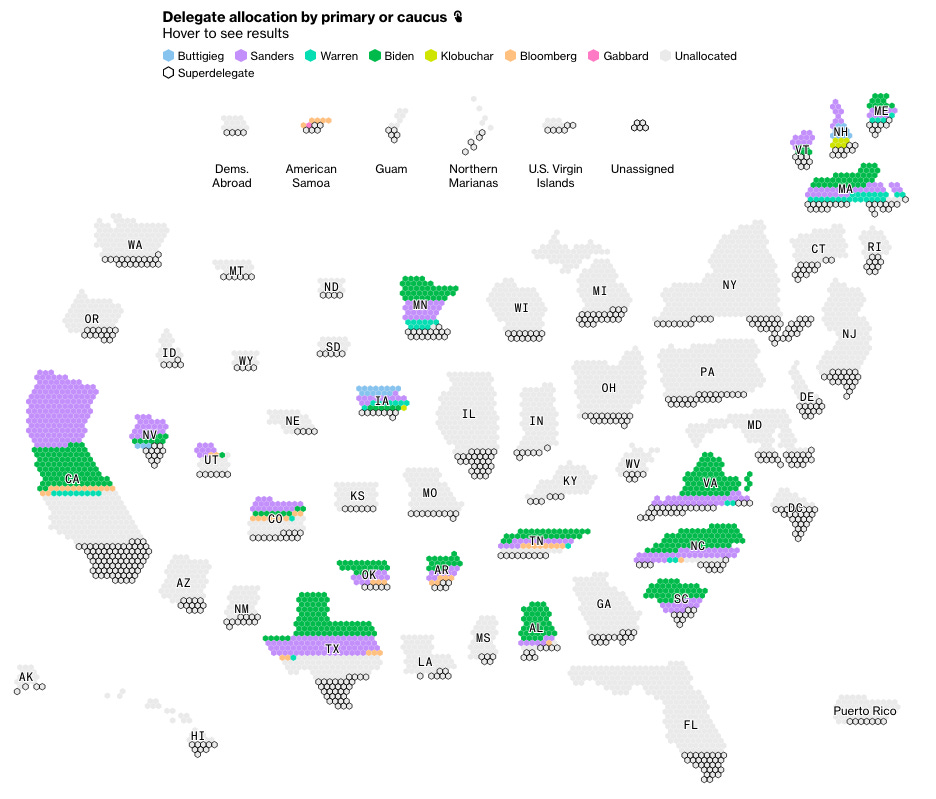
Kabir Khanna, who is one of the brains behind the CBS New Elections and Survey Unit, points out that this relationship appears at the precinct-level in North Carolina. He put this graph together, which compare’s Clinton’s vote on the horizontal axis with Biden’s on the vertical axis.
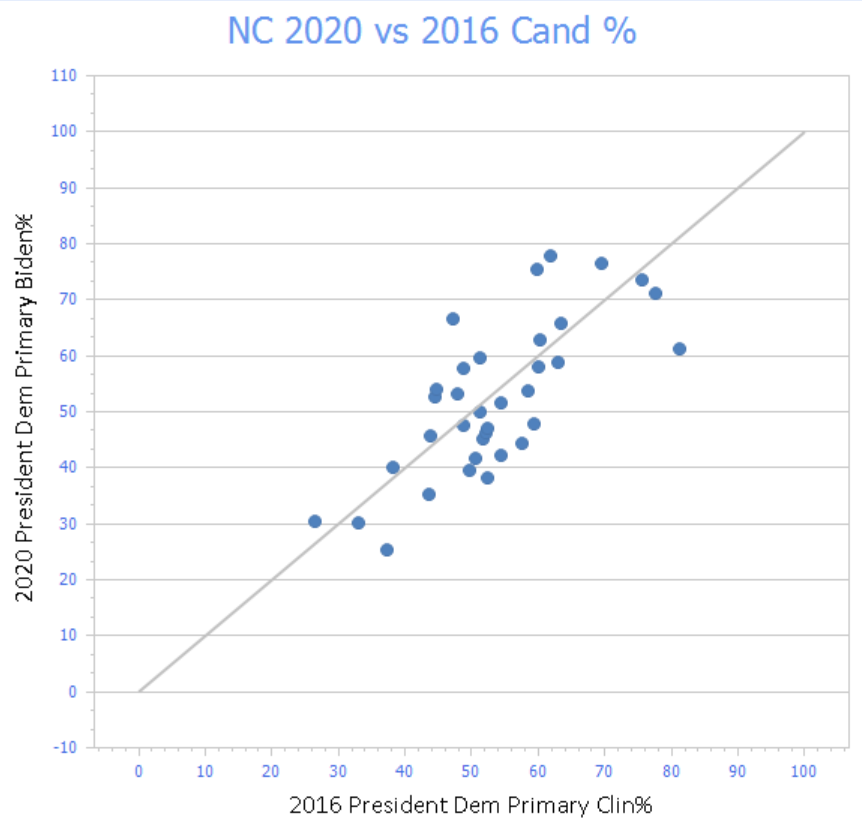
This doesn’t show up just in North Carolina, though. It’s all across the south. Here’s my map of county-level vote for both years in South Carolina, North Carolina, Virginia and Alabama:
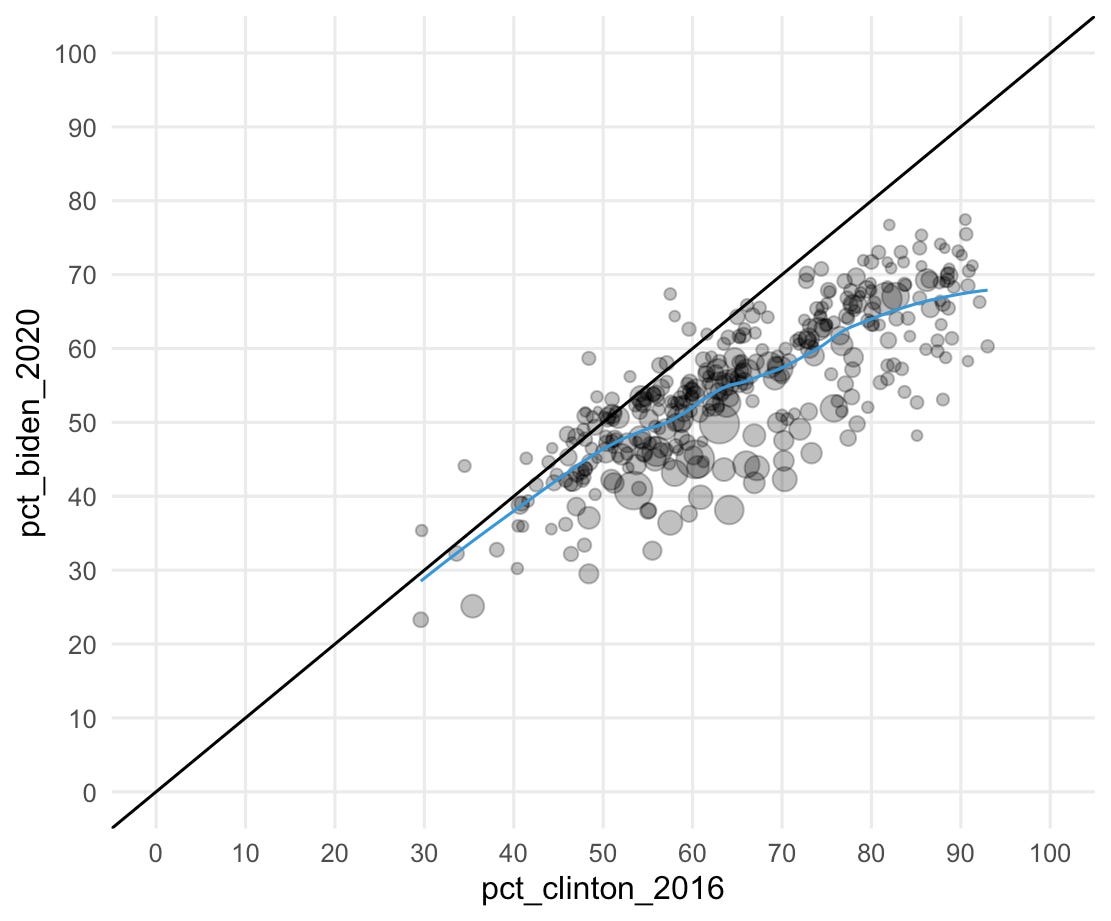
Compare this to how Bernie Sanders’s sagging performed relative to his his 2016 vote share across the states that have already voted:


3. No real signs of Bernie’s turnout revolution
One of the left’s big pitches for the electability of their candidates (especially Bernie Sanders) has been their purported ability to turn out voters, especially the young and disaffected. Well, according to Louis Jacobson, that’s not actually happening—and could be a primary cause of Bernie’s lackluster performance so far. In this graph, he compares the share of voters in Super Tuesday states who were younger than 30 in 2016 versus 2020. In all states, the youth share of the population has declined. (Note that we don’t have exit polls for California in 2016, so can’t make a comparison there.)
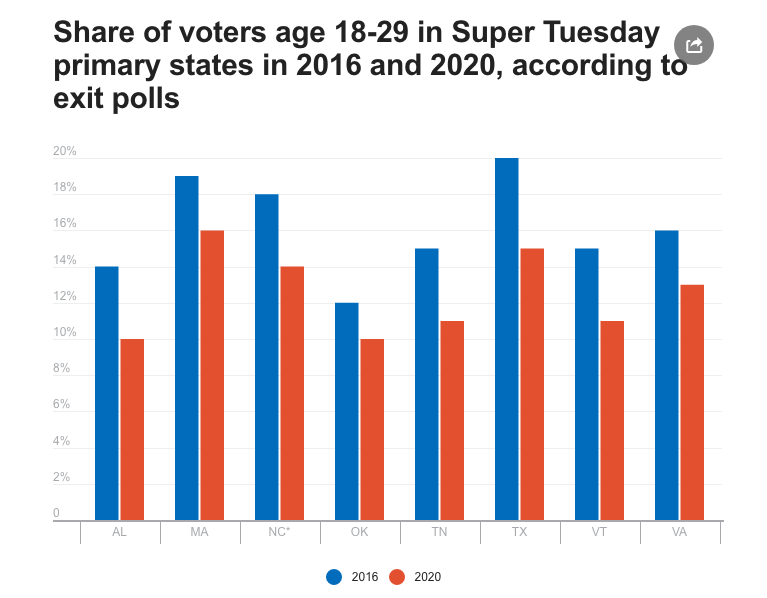
Now add to this the fact that non-voters aren’t actually as liberal as they seem, and suddenly it’s a hard sell to really buy into the turnout argument that Sanders and his surrogates have been putting out there:


Adding it all up
And now, the accounting. Here’s the narrative jumping around in my head as we come out of Super Tuesday.
Biden is quickly consolidating votes from other moderates, which should continue to propel him further and expand his current delegate lead over Sanders
Biden has a lot of big delegate hauls in the coming weeks, with diverse Mississippi and Missouri voting next week, Ohio, Florida and Georgia in the weeks after and highly educated, white states like New York, and Pennsylvania coming in April
I still don’t see any evidence that Sanders is growing his base versus 2016. While he’s pulling in some more votes among Hispanics, white voters have fled his campaign (so far), tilting the scales against him
I can’t wait to see what the next batch of polls and projections suggest. I wouldn’t say the nomination is over, as some pundits are saying, but it does look like Biden is on the path he needs to be on to lock it down in the coming months.
Editor’s note:
Thanks for reading my thoughts on this subject. And thanks for subscribing! Your membership adds up and makes all this newslettering possible (reminder: I do all this work independently). Please consider sharing online or with a friend; the more readers, the merrier!
As always, send me your tips about what you’d like to read about next, or your feedback otherwise. You can reach me via email at elliott@thecrosstab.com or @gelliottmorris on Twitter.
—Elliott



